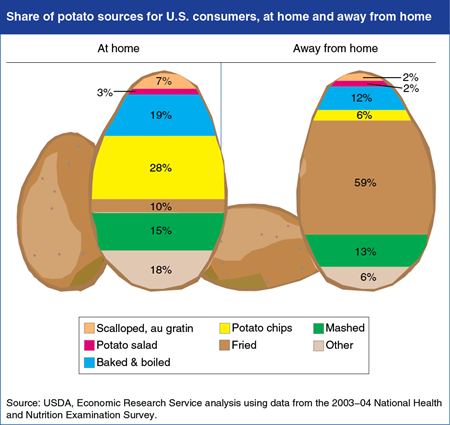Editor's Pick 2014: Best of Charts of Note
This chart gallery is a collection of the best Charts of Note from 2014. These charts were selected by ERS editors as those worthy of a second read because they provide context for the year’s headlines or share key insights from ERS research.

When advised to “eat your vegetables,” Americans may also need to be reminded “and watch how you prepare them.” ERS researchers recently looked at the types of vegetables and vegetable-containing foods eaten by Americans and found that instead of eating vegetables in their simple, unadorned state, Americans often eat vegetables in ways that add calories and sodium and reduce dietary fiber. For potatoes prepared at home, potato chips were the most commonly eaten form, accounting for 28 percent of potato consumption. In restaurants, fast food places, and other away from home eating places, fried potatoes accounted for 59 percent of potato consumption. Food intake surveys show other potato dishes, such as mashed and scalloped potatoes, are often prepared with added fats and sodium. Baked and boiled potatoes accounted for 19 percent of at-home potato consumption and 12 percent away from home, and the skin was usually not eaten, reducing dietary fiber content. This chart appears in “Healthy Vegetables Undermined by the Company They Keep” in the May 2014 issue of ERS’s Amber Waves magazine. Originally published Monday August 11, 2014.
_450px.png?v=9039.4)
During the Great Recession of 2007-09, many Americans experienced large changes in employment and income—changes that affected their food spending and intake. Using intake data from National Health and Nutrition Examination Surveys, ERS researchers found that working-age Americans cut back on the number of meals and snacks eaten away from home between 2005-06 and 2009-10. Working age adults’ total daily calories from food away from home declined as well. After accounting for age and other demographic characteristics, the number of away-from-home meals and snacks consumed by working age adults declined by about 12 percent and their away-from-home calories fell from 833 to 706 calories per day. Accounting for income did not affect the estimated declines, suggesting that the recession effect was not due to lower incomes, but instead to increased time available for shopping and preparing food at home. The statistics in this chart are from the ERS report, Changes in Eating Patterns and Diet Quality Among Working-Age Adults, 2005-2010, released January 16, 2014.

